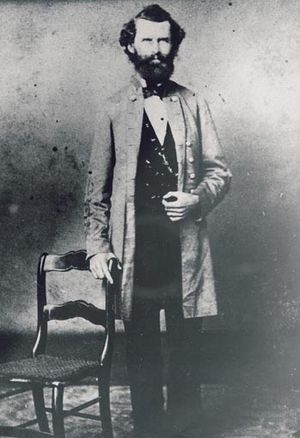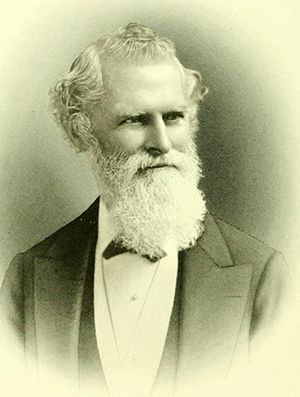George Washington Rains facts for kids
Quick facts for kids
George Washington Rains
|
|
|---|---|

George W. Rains during the Civil War
|
|
| Nickname(s) | Chief Chemist of the Confederacy |
| Born | 1817 Craven County, North Carolina |
| Died | March 21, 1898 Newburgh, New York |
| Buried |
Saint George's Cemetery, Newburgh
|
| Allegiance | United States of America Confederate States of America |
| Service/ |
|
| Years of service | 1842–1856 1861–1865 |
| Rank | Brigadier General (not confirmed) |
| Unit | 4th U.S. Artillery Bureau of Nitre and Mining |
| Commands held | Augusta Powderworks 1st Regiment, Georgia Local Defense |
| Battles/wars |
|
| Relations | Brig. Gen. Gabriel J. Rains (brother) |
| Other work | College professor, author, inventor |
George Washington Rains (1817 – March 21, 1898) was an important American soldier and inventor. He served in both the United States Army and later the Confederate States Army. Rains was a very talented engineer. He played a key role in making sure the Confederacy had enough gunpowder during the American Civil War. He was also the younger brother of another Confederate general, Gabriel J. Rains.
Contents
George Rains' Early Life and Military Career
George Rains was born in Craven County, North Carolina, in 1817. He went to the United States Military Academy at West Point. He graduated in 1842, ranking third in his class of 56 students. After graduating, he became a 2nd Lieutenant in the Corps of Engineers.
Serving in the Mexican-American War
The next year, Rains moved to the 4th U.S. Artillery Regiment. He also became a professor at West Point, teaching chemistry and geology. He fought in the Mexican–American War. He took part in several important battles, including Vera Cruz, Cerro Gordo, and Chapultepec. Because of his excellent service, he was promoted to 1st Lieutenant and later to Captain. In 1856, he officially became a full Captain. However, he resigned from the army six months later.
Life Before the Civil War
After leaving the army, Rains became an owner of the Washington & Highland Iron Works in Newburgh, New York. He was also an engineer who held patents for steam engines and boilers. This means he invented new ways to make these machines work better. He married Frances Josephine Ramsell and they had a daughter named Fanny.
George Rains' Role in the Civil War
When the American Civil War started, George Rains joined the Confederate army. He became a major in the Ordnance Department. His main job was to find and make gunpowder ingredients. He also started the production of gunpowder. His hard work helped create the Bureau of Nitre and Mining in 1862.
Building the Augusta Powderworks
Rains was promoted to lieutenant colonel. He then went to Augusta, Georgia, where he built the Confederate Powderworks at the Augusta Arsenal. He learned from British methods and used his own inventions. This made the gunpowder production very safe and efficient. At its busiest, the powderworks made about 7,000 pounds of gunpowder every day. Over the entire war, it produced more than 2,750,000 pounds. This made it the second-largest gunpowder factory in the world at that time!
Later War Service and Family
Rains was promoted to colonel on July 12, 1863. He also commanded a local defense regiment. He led this group during Sherman's March to the Sea. This was a famous campaign where Union General Sherman marched through Georgia.
Near the end of the war, Rains also took command of other military supply depots. In 1865, he was made a brigadier general in the Georgia Militia. His older brother, Gabriel J. Rains, was also a Confederate brigadier general. Gabriel was known for creating mines and booby traps. Even though they didn't work together, the brothers were known as the Bomb Brothers. George Rains himself was called the Chief Chemist of the Confederacy because of his amazing work with gunpowder.
After the War
After the Civil War ended, Rains stayed in Augusta. He chose to work in education. He became a professor of chemistry at the Medical College of Georgia. He also became the dean of the college. In 1894, he retired and moved back to Newburgh, New York. He passed away there on March 21, 1898. He was buried at Saint George's Cemetery.
See also
- List of American Civil War generals (Acting Confederate)
- Confederate Powderworks
- Bureau of Nitre and Mining


